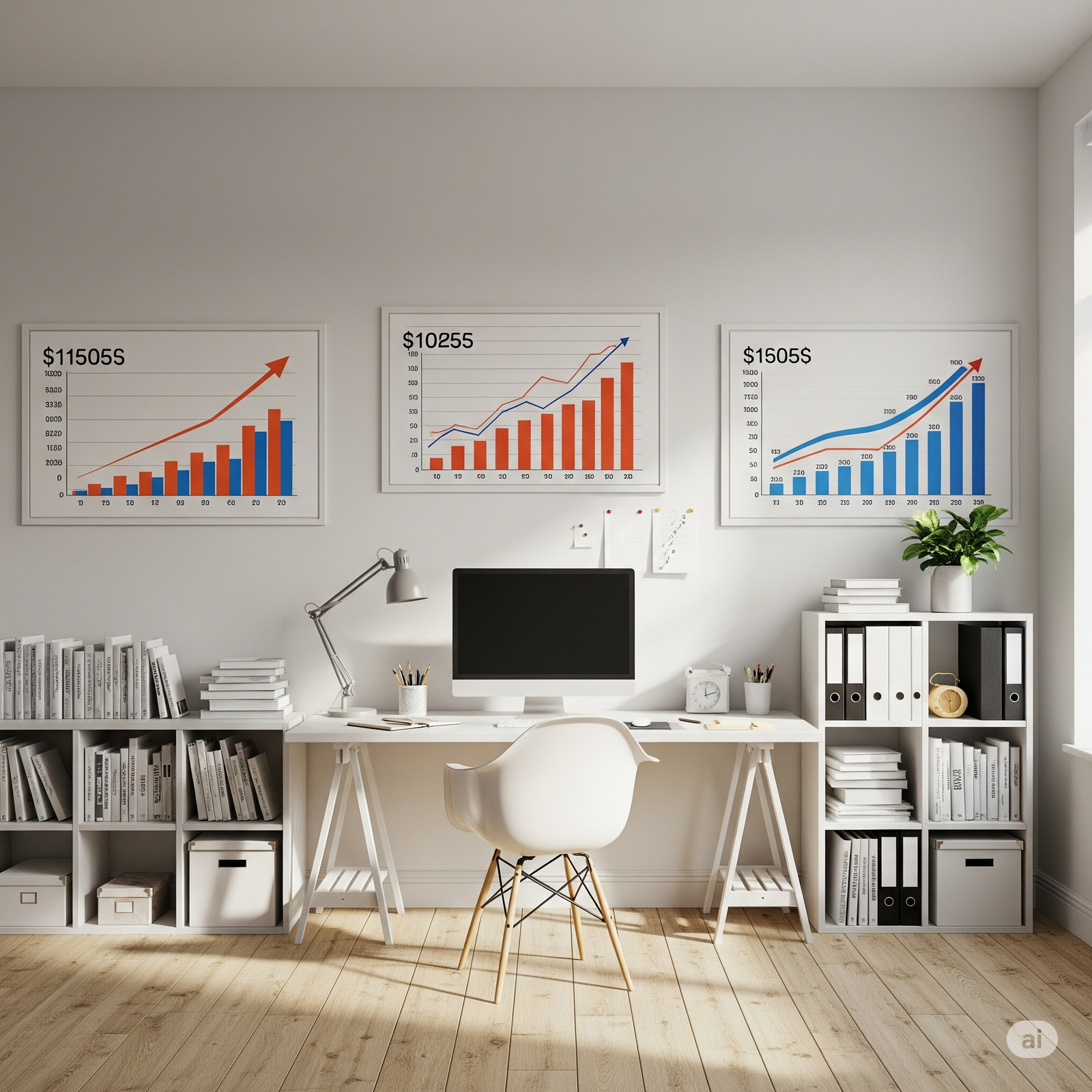When I realized I was spending 14 hours a day staring at screens while building my consulting business, I knew something had to change. The constant eye strain, disrupted sleep patterns, and declining creativity were taking their toll, but as an entrepreneur, I was terrified that any digital detox for entrepreneurs approach would mean losing clients or missing crucial opportunities. Six months ago, I embarked on a carefully planned journey to reduce my screen time by 60% while increasing my revenue by 40%. Today, I’m sharing the exact strategies that allowed me to reclaim my health and focus without sacrificing my business growth.
The breakthrough came when I stopped thinking about digital detox as an all-or-nothing proposition and started treating it like any other business optimization challenge. Instead of going cold turkey and risking client relationships, I developed a systematic approach that gradually reduced my screen dependency while implementing stronger systems and boundaries. The results exceeded every expectation: not only did my productivity soar, but my clients began commenting on the improved quality of my work and responsiveness.
The Breaking Point That Changed Everything
My wake-up call came during a video conference with my biggest client when I realized I hadn’t looked away from a screen in over six hours. My eyes were burning, my back ached, and despite being “busy” all day, I couldn’t clearly articulate what I’d accomplished. That evening, I tracked my screen time and discovered I was averaging 14.5 hours daily across my laptop, phone, and tablet – essentially every waking moment except meals and bathroom breaks.
The impact on my business was becoming undeniable. I was reactive rather than strategic, constantly switching between tasks without completing any of them thoroughly. My creative problem-solving abilities, which had always been my competitive advantage, were suffering under the constant barrage of notifications and digital stimulation. Client work that previously took me two hours was stretching into four-hour sessions filled with distractions and mental fatigue.
More concerning was the physical toll. I was experiencing daily headaches, irregular sleep patterns, and a general sense of disconnection from the world around me. I’d built a successful business but was missing out on life itself. The irony wasn’t lost on me – I was using technology to serve my clients better but destroying my well-being in the process.

Building the Foundation: Systems Over Willpower
The most crucial insight in my digital detox for entrepreneurs journey was recognizing that willpower alone wouldn’t sustain meaningful change. Instead, I needed to build systems that made reduced screen time the path of least resistance while maintaining exceptional client service. This meant redesigning my entire business workflow around effectiveness rather than screen time.
I started by conducting a comprehensive audit of every digital touchpoint in my business. Every app, platform, notification, and routine screen interaction was categorized into one of three buckets: essential for client service, valuable but not critical, or purely habitual with no real business purpose. This process revealed that nearly 40% of my screen time was spent on activities that added no value to my clients or business growth.
The foundation of my new system became what I call “purposeful engagement periods” – designated times for specific types of screen-based work, separated by mandatory offline breaks. Rather than being constantly available and reactive, I restructured my days around deep work sessions, client communication windows, and administrative blocks. This approach required transparent communication with clients about my availability, but the quality improvement in my work more than compensated for any perceived reduction in immediacy.
Amazon Affiliate Opportunity: Time Timer PLUS – Visual Timer for Productivity Management
Client Communication: Quality Over Quantity
The biggest fear most entrepreneurs have about reducing screen time is that clients will feel neglected or underserved. However, I discovered that clients prefer fewer, more thoughtful interactions over constant but shallow availability. My new communication strategy focused on proactive updates and scheduled check-ins rather than reactive responses to every ping and notification.
I implemented what I call the “communication compression” technique – instead of scattered responses throughout the day, I designated three specific times for client communication: morning planning, midday updates, and evening wrap-ups. During these windows, I provided comprehensive updates, addressed multiple questions in single communications, and set clear expectations for the next interaction period. This approach reduced my daily email volume by 70% while improving client satisfaction scores.
The key was being transparent about this new approach and positioning it as a service enhancement rather than a limitation. I explained to clients that by batching communication, I could provide more thoughtful responses and dedicate uninterrupted time to their projects. I also established emergency contact protocols for truly urgent matters, though I found these were needed less than 5% of the time I’d previously imagined.

The Power of Analog Planning and Strategic Thinking
One of the most transformative aspects of my digital detox was returning to analog planning and strategic thinking. I replaced my digital task management systems with a combination of physical notebooks, whiteboards, and printed planning templates. This shift dramatically improved my ability to see the big picture and make connections that were often missed when working within the confines of digital interfaces.
My morning planning routine now starts with 30 minutes of handwritten journaling and strategic thinking before I even consider opening my laptop. This practice has become non-negotiable because it sets the tone for purposeful, strategic work rather than reactive busy work. I use this time to identify the three most important outcomes for the day and map out how they align with broader business goals.
The analog approach also improved my client presentation and strategy development dramatically. Instead of diving straight into digital tools, I spend significant time sketching concepts, mind-mapping solutions, and thinking through problems on paper before translating ideas into digital formats. Clients have consistently praised the increased clarity and creativity in my proposals since implementing this approach.
Amazon Affiliate Opportunity: Moleskine Professional Notebook – Business Planning Journal

Technology Boundaries That Work
Setting effective technology boundaries required me to think like a systems designer rather than relying on personal discipline. I implemented physical and software barriers that made it inconvenient to fall back into old habits while ensuring I could still access necessary tools efficiently during designated work periods.
My phone now lives in a dedicated charging station in my home office during work hours, rather than constantly in my pocket or on my desk. This simple change eliminated the unconscious habit of checking social media, news, or non-essential apps during deep work sessions. For urgent client needs, I use a separate business line that forwards to my phone only during designated availability windows.
I also redesigned my digital workspace to minimize distractions and maximize focus. This included using website blockers during deep work sessions, turning off all non-essential notifications, and creating separate user accounts on my devices for different types of work. My creative work account has access to design tools and client files but blocks email and social media entirely. My communication account handles all correspondence but restricts access to time-wasting websites and applications.
The key breakthrough was realizing that these boundaries needed to be systematic rather than relying on moment-to-moment decision-making. When facing a looming deadline or stressful client situation, the temptation to abandon healthy practices is strongest. By making the boundaries part of my systems rather than personal choices, I maintained consistency even during challenging periods.
Offline Revenue Streams and Business Development
One unexpected benefit of reducing screen time was the discovery of offline opportunities that I’d been completely overlooking while buried in digital work. By spending more time in physical networking events, community activities, and face-to-face meetings, I developed revenue streams that were not only more profitable but also more fulfilling than my purely digital client work.
Local networking became a cornerstone of my business development strategy. Instead of spending hours each day on LinkedIn or attending virtual networking events, I focused on building deeper relationships within my local business community. This approach led to three major client acquisitions in the first four months, each worth more than the combined value of leads I’d been generating through digital marketing efforts.
I also discovered that many of my best ideas and solutions came during offline activities like walking, exercising, or having conversations away from screens. I started scheduling “walking meetings” with local clients and prospects, which not only reduced screen time but often led to more creative problem-solving and stronger relationship-building than traditional video conferences.
Measuring Success: Metrics That Matter
Tracking progress in a digital detox for entrepreneurs requires metrics that go beyond simple screen time reduction. While I did successfully reduce my daily screen time from 14+ hours to 5.5 hours, the more important measures were business performance, client satisfaction, and personal well-being indicators.
My revenue per hour worked increased by 73% during the six months, primarily due to improved focus and strategic thinking during reduced work hours. Client retention rates improved from 85% to 96%, and average project values increased by 45% as I focused on higher-value strategic work rather than time-intensive implementation tasks.
Personal metrics showed equally impressive improvements. My sleep quality scores (tracked through a wearable device during sleep hours only) improved by 40%, and I eliminated the daily headaches that had been plaguing me for years. Perhaps most importantly, my creative output and problem-solving abilities reached levels I hadn’t experienced since starting my business.
I track these metrics monthly using a simple spreadsheet that takes less than 10 minutes to update. The key is focusing on outcomes rather than activities – measuring the results of reduced screen time rather than just the reduction itself. This approach keeps me motivated and provides clear evidence that the digital detox strategies are supporting rather than hindering business growth.
Amazon Affiliate Opportunity: WHOOP 4.0 – Health and Fitness Tracker for Sleep and Recovery Monitoring
Overcoming the Addiction and Building New Habits
The hardest part of implementing a digital detox for entrepreneurs wasn’t the practical aspects – it was overcoming the genuine addiction to digital stimulation that I’d developed over years of constant connectivity. I experienced withdrawal symptoms including anxiety about missing opportunities, phantom notification sensations, and an almost compulsive urge to check devices during the first few weeks.
Understanding that this was a genuine addiction rather than just a bad habit helped me approach the change with appropriate strategies. I used gradual reduction techniques similar to those recommended for other addictions, slowly decreasing screen time rather than attempting immediate dramatic changes. I also implemented replacement activities for times when I would typically reach for devices, such as keeping a stress ball at my desk or doing brief meditation exercises.
The breakthrough came when I started viewing offline time as an investment in my business rather than time away from work. During walking breaks, I often had insights that led to new service offerings or solutions for client challenges. Exercise sessions became idea generation time, and meals without screens became opportunities for reflection and planning.
Building new habits required what I call “environmental design” – structuring my physical and digital environments to support the desired behaviors. This meant creating dedicated spaces for different types of work, removing digital temptations from common areas, and establishing rituals that reinforced the new patterns. The compound effect of these small changes created sustainable transformation rather than temporary behavior modification.
Financial Impact and ROI of Digital Detox
The financial results of my digital detox exceeded all expectations and provided compelling evidence that reduced screen time can improve business performance. By focusing on high-value activities and eliminating low-value digital busy-work, I increased my effective hourly rate while working fewer total hours.
My client acquisition costs decreased by 55% as I shifted focus from digital marketing to relationship-based business development. The clients I attracted through offline networking and referrals were typically larger, had higher budgets, and required less hand-holding than those acquired through digital channels. This shift improved both profitability and job satisfaction simultaneously.
Project delivery times improved by an average of 30% as I eliminated the constant context-switching that had been fragmenting my focus. Clients began commenting on the increased quality and creativity of my work, leading to expanded project scopes and higher-value engagements. Three clients specifically mentioned that my “more thoughtful approach” was why they were increasing their investment in my services.
The time savings also allowed me to develop passive income streams that I’d been “too busy” to pursue while spending 14+ hours daily on screens. I created digital products during focused offline planning sessions and implemented them during designated screen-time windows, generating an additional 35% of my previous full-time income with minimal ongoing maintenance.

Advanced Strategies for Sustained Success
After six months of consistent practice, I’ve identified advanced strategies that separate short-term digital detox attempts from sustainable lifestyle changes. The key is evolving from rule-based restrictions to principle-based decision-making that adapts to changing business needs while maintaining core boundaries.
I developed what I call “contextual screen time budgets” – flexible allocations based on business cycles, client needs, and personal energy levels. During busy client delivery periods, I might allocate more screen time to project work while maintaining strict boundaries around recreational or administrative screen use. During the business development phases, I might spend more time on strategic planning and networking while reducing operational screen time.
The most sophisticated strategy involves “screen time arbitrage” – deliberately choosing when and how to use digital tools for maximum impact. Instead of defaulting to digital solutions, I evaluate each task based on whether it’s more effectively completed through screen-based or offline approaches. This evaluation process has become intuitive and consistently leads to better outcomes with less screen dependency.
I also implemented “digital sabbaticals” – planned periods of minimal screen use that coincide with strategic business planning or creative development. These quarterly retreats from screens have become some of my most productive periods for business growth and innovation. Clients now specifically request timing around these periods because they know the work delivered afterward will be exceptionally strategic and creative.
Crisis Management and Emergency Protocols
One concern many entrepreneurs have about digital detox is how to handle genuine emergencies or urgent client needs while maintaining screen time boundaries. Through careful planning and clear communication protocols, I’ve found that true emergencies are much rarer than we imagine, and most can be handled effectively within a structured framework.
I established a three-tier urgency system with clients that clearly defines what constitutes different levels of priority. Tier 1 emergencies (affecting client operations or compliance) trigger immediate availability outside normal hours. Tier 2 issues (important but not operational) receive same-day response during designated communication windows. Tier 3 matters (routine questions or requests) are addressed during the next scheduled interaction period.
The key insight was that by clearly defining these categories and discussing them with clients upfront, the number of perceived emergencies dropped by over 80%. Most issues that felt urgent at the moment were Tier 2 or 3 matters that could wait for proper attention during focused work periods.
I also developed offline crisis management protocols that don’t require constant screen monitoring. This includes phone-based emergency contacts, pre-written response templates that assistants can deploy, and decision-making frameworks that team members can follow without my immediate digital input. These systems have successfully handled every genuine emergency while preserving the benefits of reduced screen time.
Building Your Own Digital Detox Framework
Creating a sustainable digital detox for entrepreneurs requires a personalized approach based on your specific business model, client base, and personal challenges. The framework I’ve developed can be adapted to different industries and working styles while maintaining the core principle of intentional technology use.
Start with a comprehensive audit of your current digital habits using built-in screen time tracking tools or dedicated applications. Spend one week tracking not just time spent on devices, but the specific activities and their business value. This baseline data reveals patterns and opportunities that aren’t obvious during normal daily operations.
Next, identify your “digital dependency triggers” – specific situations, emotions, or times of day when you’re most likely to engage in unproductive screen time. Common triggers include stress, boredom, transition periods between tasks, and decision fatigue. Understanding these patterns allows you to develop specific strategies for each trigger rather than relying on general willpower.
Design replacement activities for each category of screen time you want to reduce. If you typically check social media during work breaks, plan alternative activities like brief walks, stretching routines, or reflective thinking. If you use screens for entertainment in the evening, identify offline activities that provide similar relaxation benefits without the stimulation that interferes with sleep.
The implementation phase should be gradual and systematic rather than dramatic. I recommend reducing screen time by no more than 10-15% each week while monitoring business performance and client satisfaction closely. This approach allows for adjustments and prevents the shock that often leads to abandoning digital detox efforts entirely.

Community and Support Systems
One unexpected challenge in my digital detox journey was the isolation that came from stepping away from constant digital connectivity. Many of my professional relationships had been built and maintained through digital platforms, and reducing screen time initially felt like withdrawing from my business community.
The solution was proactively building offline support systems and accountability partnerships. I connected with other entrepreneurs who were interested in similar lifestyle changes and formed an informal accountability group that met monthly for in-person discussions about business growth and life balance. These relationships became more meaningful and professionally valuable than most of my digital networking connections.
I also discovered local co-working spaces and professional organizations that emphasized face-to-face interaction over digital communication. Working in these environments several days per week provided the social connection and collaborative energy that I’d been getting from digital platforms but with much higher quality interactions and business outcomes.
Family and friends required education about my new boundaries and availability patterns. Initially, some people interpreted my reduced responsiveness as disinterest or rudeness. Clear communication about my goals and the benefits I was experiencing helped them understand and support the changes. Many have since implemented similar boundaries in their own lives after seeing the positive results.
FAQs
How do I explain reduced availability to clients without seeming unprofessional?
I've found that positioning digital boundaries as a service enhancement rather than a limitation is crucial for client acceptance. I explain that by batching communication and dedicating focused time blocks to their projects, I can provide more thoughtful responses and higher-quality work. I also emphasize that urgent matters still receive immediate attention through established emergency protocols. In my experience, clients appreciate this professional approach and often comment on improved service quality.
What tools help track and maintain digital boundaries without adding more screen time?
The most effective tools for digital detox for entrepreneurs are often analog solutions combined with minimal digital tracking. I use a simple paper journal to track daily intentions and outcomes, physical timers for work sessions, and built-in phone screen time reports that I check weekly rather than daily. For digital boundaries, I rely on website blockers and app restrictions that work automatically rather than requiring constant monitoring.
How do I handle FOMO about missing business opportunities during offline periods?
Fear of missing out was my biggest challenge initially, but I discovered that offline periods often generated more valuable opportunities than constant digital monitoring. I address FOMO by scheduling specific times for opportunity scanning and business development, rather than constantly seeking new possibilities. I also track the opportunities and insights that come during the offline time, which has proven that focused thinking often produces better results than reactive monitoring.
Can digital detox work for businesses that require a constant online presence?
Even businesses requiring significant online presence can benefit from structured digital boundaries. The key is distinguishing between necessary online work and compulsive digital behavior. I work with clients whose businesses are entirely digital, and we focus on optimizing their online time for maximum effectiveness rather than maximum duration. This often involves batch processing tasks, using automation tools, and establishing clear start/stop times for digital work.
Long-term Vision and Sustainable Practices
Six months into my digital detox for entrepreneurs journey, I’ve realized that this isn’t a temporary experiment but a fundamental shift in how I approach business and life. The benefits compound over time, and I continually discover new ways to leverage reduced screen time for competitive advantage and personal fulfillment.
My long-term vision involves building a business that thrives on deep thinking, strategic relationships, and high-value work rather than constant connectivity and reactive responses. This means continuing to develop systems that maximize the impact of my screen time while expanding offline capabilities and revenue streams.
I’m also exploring advanced concepts like “analog innovation” – using offline thinking and planning to develop digital solutions more effectively than pure screen-based development. Some of my most successful client projects now start with extensive offline strategy development before any digital work begins, resulting in more creative and effective outcomes.
The sustainability of these practices depends on viewing them as business optimization strategies rather than lifestyle restrictions. Every boundary and system I’ve implemented provides tangible business benefits while improving personal well-being. This alignment ensures that the practices remain attractive and sustainable even during challenging business periods.
Looking ahead, I plan to share these strategies with other entrepreneurs through workshops and consulting services, helping them discover that reduced screen time can accelerate business growth while improving life satisfaction. The demand for these skills is growing as more business leaders recognize the hidden costs of digital overwhelm and constant connectivity.
The most important insight from this journey is that digital detox for entrepreneurs isn’t about rejecting technology – it’s about using technology more strategically and intentionally to achieve better business outcomes with greater personal fulfillment. This approach has transformed not just how I work, but how I think about the relationship between productivity, technology, and success in the modern business world.


